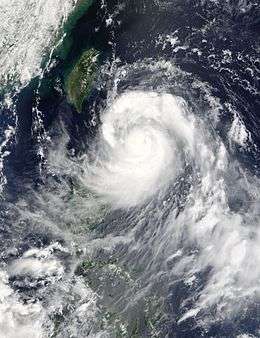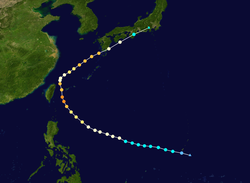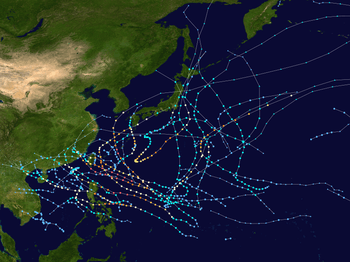Typhoon Malakas (2016)
Typhoon Malakas (ma-la-KAS, [mɐlɐˈkas]; Filipino word meaning "strong"), known in the Philippines as Typhoon Gener, was a powerful tropical cyclone which affected Taiwan and Japan in mid September 2016. It was the sixteenth named storm and the sixth typhoon of the annual typhoon season in 2016.
| Typhoon (JMA scale) | |
|---|---|
| Category 4 typhoon (SSHWS) | |
 Typhoon Malakas intensifying and nearing Taiwan on September 16 | |
| Formed | September 11, 2016 |
| Dissipated | September 23, 2016 |
| (Extratropical after September 20) | |
| Highest winds | 10-minute sustained: 175 km/h (110 mph) 1-minute sustained: 215 km/h (130 mph) |
| Lowest pressure | 930 hPa (mbar); 27.46 inHg |
| Fatalities | 1 total |
| Damage | $300 million (2016 USD) |
| Areas affected | Mariana Islands, Taiwan, Japan |
| Part of the 2016 Pacific typhoon season | |
Meteorological history

During September 11, both the JMA and the JTWC started to monitor Tropical Depression 18W approximately 58 km (36 mi) south of Hagåtña, Guam.[1][2] Due to decent organization and improved banding, JTWC upgraded 18W to a tropical storm.[3][4] 18W was fully upgraded to a named tropical storm by the JMA few hours later and was named Malakas.[5] By September 13, Malakas had improved in its organization and was already strengthening with deep convection wrapping into its LLCC;[6] the JMA upgraded Malakas to a severe tropical storm thereafter.[7] In the same time, Malakas had entered the Philippine area of Responsibility, with PAGASA assigning the local name Gener.[8] Later, it was reported that Malakas was located in marginal conditions for further development due to wind shear caused by the proximity of the outflow of Typhoon Meranti.[9] However the JMA upgraded Malakas to a typhoon three hours later.[10] With improving conditions, it was reported that a cold dense overcast was forming and the JTWC upgraded Malakas to a Category 1 typhoon during the next day.[11]
By September 15, Malakas was over in very favorable conditions of Sea surface temperature (SSTs) of nearly 30 °C (86 °F) and was later upgraded to a Category 2 typhoon.[12][13] After maintaining this intensity for six hours, satellite imagery depicted an improved deep convection and a well-defined 10 nmi (19 km; 12 mi) eye feature, as Malakas rapidly intensified into a Category 4 typhoon.[14] Malakas reached its peak intensity with 1-minute sustained winds of 215 km/h (130 mph) and a minimum pressure of 930 hPa (27.46 inHg). The JMA had 10-minute sustained winds of 175 km/h (110 mph) on midnight of September 17.[15] Shortly thereafter, its eye became cloud-filled and ragged and weakened to a Category 3 typhoon.[16] Later in that same day, Malakas further weakened to a Category 2 as satellite imagery depicted warming cloud tops, decreasing convection and SSTs of only around 28 °C (82 °F).[17] However, by September 18, Malakas started to re-intensify as it moved east-northeastward.[18] Malakas reached its secondary peak intensity on September 19, but only as a Category 3 typhoon.[19] Malakas then started to weaken due to land interaction with Japan.[20] On September 20, the JTWC downgraded Malakas to a tropical storm,[21] while the JMA downgraded it to a severe tropical storm,[22] because at around 00:00 JST on September 20 (15:00 UTC on September 19), Malakas made landfall over the Ōsumi Peninsula in Japan.[23] It subsequently crossed Cape Muroto at around 11:00 JST (02:00 UTC) and made landfall over Tanabe at around 13:30 JST (04:30 UTC).[24][25] Both agencies issued their final advisory later that day as it became extratropical.[26][27]
Impact
Taiwan
Malakas passed about 81 mi (130 km) to the east of Taipei on September 17,[28] producing heavy rain and strong winds to northern Taiwan.[29] Meanwhile, Taitung City was affected by Foehn wind. At 15:11 TST (07:11 UTC), a weather station recorded the temperature of 36.1 °C (97.0 °F).[30] Overall, damages from Malakas to Taiwan was minimal.
Japan
Malakas passed over the Yaeyama Islands on September 17, producing heavy rain and hurricane-force winds, especially in Taketomi. Malakas also caused widespread damage to the Japanese archipelago, Yamakawa Station to Makurazaki Station of the Ibusuki Makurazaki Line have to be closed due to falling trees.[31] In Nobeoka City, the recorded rainfall on September 20 during the previous 24 hours was 444.5 mm (17.50 in). Heavy rains caused flooding to these areas.[32] In Tokushima Prefecture, the weather station also recorded the rainfall of 85.5 mm (3.37 in).[33] Malakas also brought heavy rains to Kansai region. In Sumoto City, the weather station recorded the rainfall of 85.5 mm (3.37 in) in 1 hour.[33] Agricultural damage were about JP¥26.18 billion (US$257 million).[34] Overall damage nationwide were at US$300 million.[35]
References
- https://www.webcitation.org/6kT0mULka
- "Tropical Depression 18W (Eighteen) Warning Nr 001". Joint Typhoon Warning Center. September 11, 2016.
- "Prognostic Reasoning for Tropical Storm 18W (Eighteen) Warning Nr 03". Joint Typhoon Warning Center. September 12, 2016.
- "Tropical Storm 18W (Eighteen) Warning Nr 003". Joint Typhoon Warning Center. September 11, 2016.
- "TS 1616 MALAKAS (1616) UPGRADED FROM TD". Japan Meteorological Agency. September 12, 2016.
- "Prognostic Reasoning for Tropical Storm 18W (Malakas) Warning Nr 06". Joint Typhoon Warning Center. September 13, 2016.
- "STS 1616 MALAKAS (1616) UPGRADED FROM TS". Japan Meteorological Agency. September 13, 2016.
- "Severe Weather Bulletin #1: Severe Tropical Storm "GENER" (MALAKAS)". PAGASA. September 13, 2016.
- "Prognostic Reasoning for Tropical Storm 18W (Malakas) Warning Nr 08". Joint Typhoon Warning Center. September 13, 2016.
- "TY 1616 MALAKAS (1616) UPGRADED FROM STS". Japan Meteorological Agency. September 13, 2016.
- "Prognostic Reasoning for Typhoon 18W (Malakas) Warning Nr 14". Joint Typhoon Warning Center. September 14, 2016.
- "Prognostic Reasoning for Typhoon 18W (Malakas) Warning Nr 15". Joint Typhoon Warning Center. September 15, 2016.
- "Typhoon 18W (Malakas) Warning Nr 016". Joint Typhoon Warning Center. September 15, 2016.
- "Prognostic Reasoning for Typhoon 18W (Malakas) Warning Nr 21". Joint Typhoon Warning Center. September 16, 2016.
- "TY 1616 MALAKAS (1616)". Japan Meteorological Agency. September 17, 2016.
- "Prognostic Reasoning for Typhoon 18W (Malakas) Warning Nr 22". Joint Typhoon Warning Center. September 17, 2016.
- "Prognostic Reasoning for Typhoon 18W (Malakas) Warning Nr 25". Joint Typhoon Warning Center. September 17, 2016.
- "Prognostic Reasoning for Typhoon 18W (Malakas) Warning Nr 28". Joint Typhoon Warning Center. September 18, 2016.
- "Prognostic Reasoning for Typhoon 18W (Malakas) Warning Nr 30". Joint Typhoon Warning Center. September 19, 2016.
- "Prognostic Reasoning for Typhoon 18W (Malakas) Warning Nr 32". Joint Typhoon Warning Center. September 19, 2016.
- "Prognostic Reasoning for Tropical Storm 18W (Malakas) Warning Nr 35". Joint Typhoon Warning Center. September 20, 2016.
- "STS 1616 MALAKAS (1616) DOWNGRADED FROM TY". Japan Meteorological Agency. September 20, 2016.
- "平成28年 台風第16号に関する情報 第89号" (in Japanese). Japan Meteorological Agency. September 19, 2016. Archived from the original on September 19, 2016. Retrieved September 19, 2016.
- "平成28年 台風第16号に関する情報 第102号" (in Japanese). Japan Meteorological Agency. September 20, 2016. Archived from the original on September 20, 2016. Retrieved September 20, 2016.
- "平成28年 台風第16号に関する情報 第106号" (in Japanese). Japan Meteorological Agency. September 20, 2016. Archived from the original on September 20, 2016. Retrieved September 20, 2016.
- "Prognostic Reasoning for Tropical Depression 18W (Malakas) Warning Nr 37". Joint Typhoon Warning Center. September 20, 2016.
- "DEVELOPED LOW FORMER 1616 MALAKAS (1616)". Japan Meteorological Agency. September 20, 2016.
- Everton Fox (September 19, 2016). "Thousands evacuated as Typhoon Malakas clips Taiwan". Al Jazeera. Retrieved October 16, 2016.
- 唐鎮宇 (September 17, 2016). "馬勒卡走直線 北部風雨「正要開始」". Apple daily (in Chinese). Retrieved October 16, 2016.
- 盧太城 (September 17, 2016). "颱風馬勒卡過境 台東吹焚風". Central News Agency (in Chinese). Retrieved October 16, 2016.
- "台風16号被害 全半壊95棟、浸水454棟 鹿児島県内" (in Japanese). 南日本新聞社. September 22, 2016. Retrieved October 16, 2016.
- "台風16号 住宅浸水、車水没 宮崎・延岡で北川氾濫" (in Japanese). 毎日新聞. September 20, 2016. Retrieved October 16, 2016.
- "台風16号、太平洋沿岸横断 各地で記録的大雨" (in Japanese). 中国新聞アルファ. September 20, 2016. Archived from the original on September 21, 2016. Retrieved October 16, 2016.
- "平成28年台風第16号による被害状況" (in Japanese). Ministry of Agriculture, Forestry and Fisheries. April 28, 2017. Retrieved April 30, 2017.
- Global Catastrophe Recap October 2016 (pdf) (Report). Aon Benfield. November 9, 2016. Retrieved November 11, 2016.
External links
| Wikimedia Commons has media related to Typhoon Malakas (2016). |
- JMA General Information of Typhoon Malakas (1616) from Digital Typhoon
- JMA Best Track Data of Typhoon Malakas (1616) (in Japanese)
- 19W.MALAKAS from the U.S. Naval Research Laboratory
